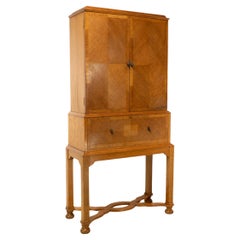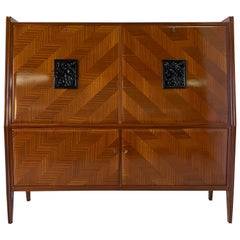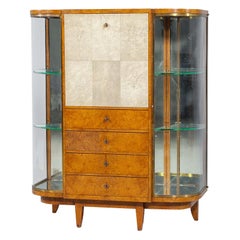Charles Spooner Secretaires
Charles Spooner is noted as one of the most influential people and also credited as one of the fathers of the Arts and Crafts Movement. Born at St Mary's Hospital, Paddington (London), Spooner was the second of 5 children of Charles Spooner and Sarah Frances Trinder, who lived at Brook Green, Hammersmith. Spooner became an architect and an instructor of furniture design at the London County Council's Central School of Arts and Crafts. He was a pupil and then assistant of Sir A W Blomfield and in 1890 won the RIBA’s Soane Medallion (Proc RIBA). He specialised in smaller churches and houses turning out some beautiful and complete buildings. He was influenced by E W Godwin and contemporary American architects such as H H Richardson. He was a member of the Society and Protection of Ancient Buildings and the Art Workers Guild, he worked in the tradition of William Morris, teaching furniture making and designing stained glass. These activities took up an increasing amount of his time in later life. His work was displayed at all the exhibitions of the Arts and Crafts Exhibition Society from 1890 to 1928, including an exhibition at the Grosvenor Gallery in January of 1913. He was also the secretary of the Woods Handicraft Society, and with Voysey exhibited significant pieces in The Arts & Crafts Exhibition Society show of 1890 and 1893. Spooner founded Elmdon and Co with his own workshops at 1 Ravenscroft Park in Hammersmith and held an exhibition at The Alpine Club in April 1905 not a stones throw from where William Morris famous Hammersmith rugs were made. He taught first at The Guild Of Handicraft and then at The Central School of Arts and Crafts and in 1908 was named by Ashbee alongside Lethaby, Gimson and Barnsley as one of the four most influential people with whom The Arts and Crafts Period is identified. Spooner's designs were also made by J.P.White who also made furniture to the designs of M.H.Ballie Scott. Spooner was Lionised by Herman Muthesis in his very famous book 'Das Englishe Haus'. Spooner was a work alcoholic, loved his work passionately to the point of excess. He was a very prolific designer and a true heavyweight of the period.
1920s English Arts and Crafts Vintage Charles Spooner Secretaires
Oak
1950s Italian Mid-Century Modern Vintage Charles Spooner Secretaires
Mahogany, Maple
1930s French Art Deco Vintage Charles Spooner Secretaires
Brass, Chrome
19th Century Antique Charles Spooner Secretaires
Wood
Late 19th Century Swedish Biedermeier Antique Charles Spooner Secretaires
Birch
1750s German Baroque Antique Charles Spooner Secretaires
Walnut
19th Century Antique Charles Spooner Secretaires
Cherry, Walnut
19th Century Antique Charles Spooner Secretaires
Wood
19th Century Antique Charles Spooner Secretaires
Ebony, Walnut
18th Century English Georgian Antique Charles Spooner Secretaires
Brass
1740s English George III Antique Charles Spooner Secretaires
Mahogany
19th Century Austrian Antique Charles Spooner Secretaires
Ebony, Walnut


